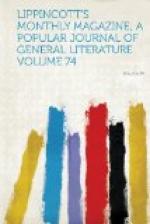From this time on, his business life, though of long duration, was uneventful, and may be summed up in very few words. From his original starting-place at No. 67 North Third Street, he removed, four years later, to a store on the site now occupied by a portion of the publishing house of J.B. Lippincott Company. Here he remained until 1842, and then established himself in the building mentioned at the beginning of this article, where he continued to live until the final closing up of his business in 1869.
It does not appear that Mr. Mickley was ever actively engaged in the manufacture of piano-fortes. He continued, however, to tune pianos to the end of his life; and it is reported that he could never be induced to alter his terms from the original fee of one dollar which was customary forty years ago. He also became noted far and wide as a repairer of violins and other stringed instruments. At one time, a violin which had belonged to George Washington was sent to him for this purpose. Ole Bull, who happened to be in town at the time, hearing of the circumstance, hastened to the shop for the purpose of examining and playing upon the historic instrument. Mickley also became an authority in regard to the value and authenticity of these instruments, although he never indulged in the passion of making collections in this field. His minuteness of observation was frequently manifested. While stopping at Venice in 1870 he notes down in his diary, “A man came to the hotel with some violins for sale. Among them was a Hieronymus Amati. It was a good one, but the head and neck were not genuine.” At another time, a violin was sent to his place from a distant locality for repairs. The instrument was preceded by a lengthy letter beseeching his special care for its welfare, and setting forth in extravagant terms its great intrinsic value and its peculiarly interesting “belongings.” Anticipating a treasure, Mr. Mickley sent for some violin-connoisseurs to enjoy with him a first sight of the precious instrument. On opening the express-package a very worthless “fiddle” was revealed. After the laugh had gone round, he said dryly, “I think the value of this must be in its ‘belongings.’”




